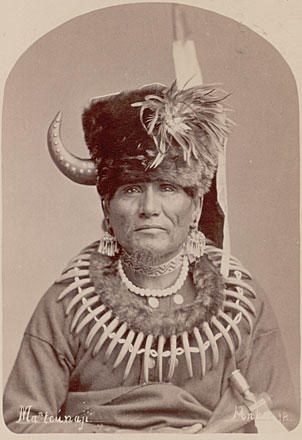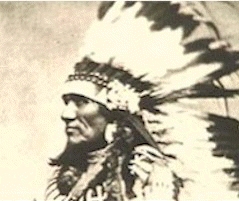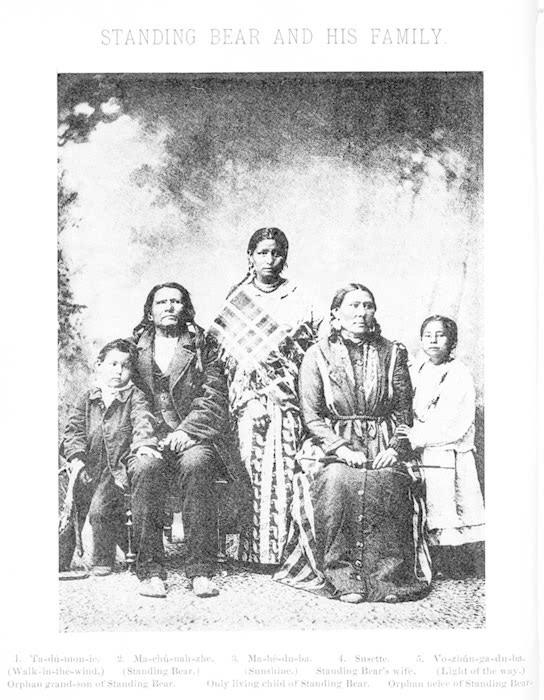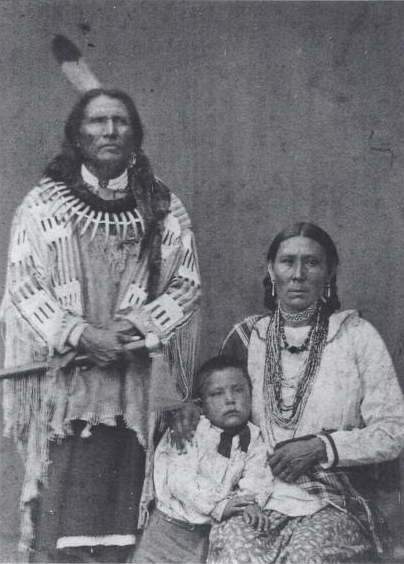Post by Historian on Jun 17, 2009 9:07:18 GMT -5
Standing Bear (aka Ma-chú Na-zhe) successfully argued in U.S. District Court in 1879 that Native Americans are "persons within the meaning of the law" and have the right of habeas corpus. His wife Susette Primeaux was also a signatory on the 1879 writ that initiated the famous court case.
In early times the Ponca were driven southward by the Sioux. The tribe suffered decimation by smallpox. (Lewis and Clark numbered them at only 200.) At the time Standing Bear was born [circa 1834], the Ponca people had settled in an area around the mouth of the Niobrara River. By 1858 settlers came into the area claimed by the Ponca and many lives were lost. To end the raids, the government moved the Ponca to Indian Territory. The Ponca relinquished all land they had claimed except for a small reserve along the Niobrara. They tried to change from nomadic buffalo hunters to farmers. In the Treaty of Fort Laramie (1868), the government mistakenly included the Ponca's land in the territory assigned to the Sioux. Subsequently, the Sioux raided the (present day) Oklahoma.
When the Ponca learned they were to be moved to Indian Territory in 1876, they sent ten chiefs with a United States agent to look over the land and its prospects. They were to make a decision for the Ponca tribe. Based on what they learned, the chiefs could not make a favorable report. The tribe voted not to go to Indian Territory. The government then sent the Ponca to Indian Territory with or without their consent.
The Ponca arrived in Oklahoma territory too late to plant crops. They were not prepared for winter, causing many deaths, including the death of Standing Bear's son, Bear Shield, whose last request was to be buried in the Niobrara River valley of Nebraska. Standing Bear wanted to bury his son on Ponca soil, and with thirty others traveled back to the Niobrara, some 600 miles from their station in Oklahoma. They reached the Omaha Reservation, where they were welcomed as relatives, but word of their arrival in Nebraska soon reached the government. They were arrested by Brigadier General George Crook, of the U.S. Army, who was under orders from the Secretary of the Interior, Carl Schurz. Standing Bear and the others were taken to Fort Omaha and detained. Although they were ordered back to Indian Territory at once, Crook, appalled by the conditions under which the Poncas were held, delayed their return so they could rest, regain their health, and seek legal redress.
Crook told their story to Thomas Tibbles of the Omaha Daily Herald, who publicized it widely. Attorney John L. Webster offered his services pro bono, and he was joined by Andrew J. Poppleton, chief attorney of the Union Pacific Railroad, who also volunteered his services. In April 1879, Standing Bear sued for a writ of habeas corpus in U.S. District Court in Omaha, Nebraska. The case is called United States ex rel. Standing Bear v. Crook. General Crook was named as the formal defendant because he was holding the Poncas under color of law.
On May 12, 1879, Judge Elmer S. Dundy ruled that "an Indian is a person" within the meaning of the habeas corpus act, and that the government had failed to show a basis under law for the Poncas' captivity. They were therefore freed immediately. This case received the attention of the Hayes administration, and provisions were made for some of the tribe to return to the Niobrara valley.
Between October 1879 and 1883, Standing Bear traveled in the eastern United States and spoke about Indian rights in forums sponsored by Indian advocate and former abolitionist Wendell Phillips. Standing Bear did not speak any English, so his story was translated by two Omahas. He was accompanied by Thomas Tibbles, then married to Susette (Bright Eyes) LaFlesche, and her brother Francis LaFlesche [aka White Swan]. Standing Bear won the support of poet Henry Wadsworth Longfellow and other prominent people.
After he returned from the East, Standing Bear resided at his old home on the Niobrara with 170 Ponca and farmed his land. He died in 1908 and is buried on a hill overlooking the site of his birth. Bear Shield was his eldest son.
Taken from:
en.wikipedia.org/wiki/Standing_Bear
*******
Standing L-R: unknown, Big Elk, Lone Chief, Smoke Maker, Standing Bear
Sitting L-R: unknown (in chair), Big Snake, Black Crow, Hairy Grizzly Bear, The Chief - Ponca - circa 1870

Standing Bear - Ponca - circa 1870

Standing Bear – Ponca – circa 1870
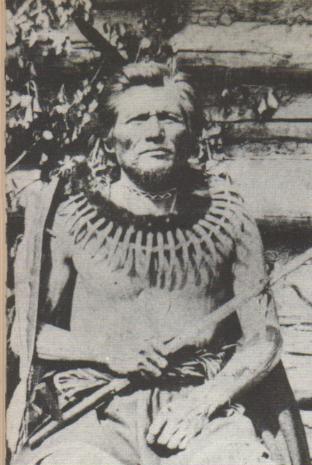
Standing Bear (seated second from right) – Ponca – circa 1870
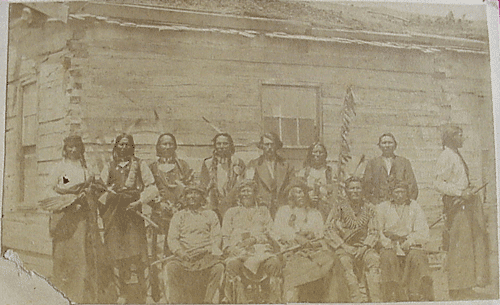
Standing Bear - Ponca - 1877

Standing Bear - Ponca - 1877

Standing Bear - Ponca - 1877

Standing L-R: John Baptiste Barnaby (Otoe/Pawnee, Interpreter), Charles LeClaire (Ponca/French Canadian, Interpreter)
Sitting L-R: Big Elk, Standing Buffalo Bull, White Eagle, Standing Bear - Ponca - 1877

Standing L-R: Big Snake, John Baptiste Barnaby (Otoe/Pawnee, Interpreter), White Eagle, Charles LeClaire (Ponca/French Canadian, Interpreter), The Chief
Sitting L-R: Black Crow, Big Elk, Standing Bear, Standing Buffalo Bull, White Swan (aka Frank LaFlesche Sr., Ponca/French Canadian), Smoke Maker
Reclining: Hairy Grizzly Bear - Ponca - 1877

Standing L-R: Hairy Grizzly Bear, Big Snake, The Chief, Black Crow, White Swan
Sitting L-R: Standing Bear, Standing Buffalo Bull, White Eagle, Big Elk, Smoke Maker

Standing L-R: Standing Bear, Walk In The Wind (orphan grandson of Standing Bear)
Sitting: Susette Primeaux (daughter of Lone Chief, and wife of Standing Bear) - Ponca - circa 1879
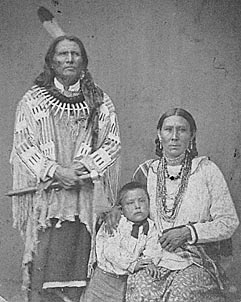
Standing and sitting L-R: Walk In The Wind (orphan grandson of Standing Bear), Standing Bear, Sunshine (only living child of Standing Bear), Susette Primeaux (daughter of Lone Chief, and wife of Standing Bear), Light Of The Way (orphan niece of Standing Bear) - Ponca - circa 1880

Standing Bear (standing 4th from right) - Ponca
White Eagle (standing 2nd from right) - Ponca
Hairy Grizzly Bear (sitting on far left) - Ponca
The Chief (sitting 2nd from left) - Ponca
Standing Buffalo Bull (sitting 3rd from left) - Ponca - no date

Standing Bear - Ponca - 1881

Standing Bear - Ponca - 1881

Standing Bear - Ponca - no date

Standing Bear - Ponca - no date

Standing L-R: White Eagle (Ponca), Standing Buffalo Bull (Ponca), Ben Beveridge, Standing Bear (Ponca)
Sitting: unknown - no date

White Eagle, Standing Bear - Ponca - no date

Standing Bear - Ponca - no date

Standing Bear - Ponca - no date

Susette Primeaux (daughter of Lone Chief, and wife of Standing Bear), Light Of The Way (orphan niece of Standing Bear), Standing Bear - Ponca - 1904?

In early times the Ponca were driven southward by the Sioux. The tribe suffered decimation by smallpox. (Lewis and Clark numbered them at only 200.) At the time Standing Bear was born [circa 1834], the Ponca people had settled in an area around the mouth of the Niobrara River. By 1858 settlers came into the area claimed by the Ponca and many lives were lost. To end the raids, the government moved the Ponca to Indian Territory. The Ponca relinquished all land they had claimed except for a small reserve along the Niobrara. They tried to change from nomadic buffalo hunters to farmers. In the Treaty of Fort Laramie (1868), the government mistakenly included the Ponca's land in the territory assigned to the Sioux. Subsequently, the Sioux raided the (present day) Oklahoma.
When the Ponca learned they were to be moved to Indian Territory in 1876, they sent ten chiefs with a United States agent to look over the land and its prospects. They were to make a decision for the Ponca tribe. Based on what they learned, the chiefs could not make a favorable report. The tribe voted not to go to Indian Territory. The government then sent the Ponca to Indian Territory with or without their consent.
The Ponca arrived in Oklahoma territory too late to plant crops. They were not prepared for winter, causing many deaths, including the death of Standing Bear's son, Bear Shield, whose last request was to be buried in the Niobrara River valley of Nebraska. Standing Bear wanted to bury his son on Ponca soil, and with thirty others traveled back to the Niobrara, some 600 miles from their station in Oklahoma. They reached the Omaha Reservation, where they were welcomed as relatives, but word of their arrival in Nebraska soon reached the government. They were arrested by Brigadier General George Crook, of the U.S. Army, who was under orders from the Secretary of the Interior, Carl Schurz. Standing Bear and the others were taken to Fort Omaha and detained. Although they were ordered back to Indian Territory at once, Crook, appalled by the conditions under which the Poncas were held, delayed their return so they could rest, regain their health, and seek legal redress.
Crook told their story to Thomas Tibbles of the Omaha Daily Herald, who publicized it widely. Attorney John L. Webster offered his services pro bono, and he was joined by Andrew J. Poppleton, chief attorney of the Union Pacific Railroad, who also volunteered his services. In April 1879, Standing Bear sued for a writ of habeas corpus in U.S. District Court in Omaha, Nebraska. The case is called United States ex rel. Standing Bear v. Crook. General Crook was named as the formal defendant because he was holding the Poncas under color of law.
On May 12, 1879, Judge Elmer S. Dundy ruled that "an Indian is a person" within the meaning of the habeas corpus act, and that the government had failed to show a basis under law for the Poncas' captivity. They were therefore freed immediately. This case received the attention of the Hayes administration, and provisions were made for some of the tribe to return to the Niobrara valley.
Between October 1879 and 1883, Standing Bear traveled in the eastern United States and spoke about Indian rights in forums sponsored by Indian advocate and former abolitionist Wendell Phillips. Standing Bear did not speak any English, so his story was translated by two Omahas. He was accompanied by Thomas Tibbles, then married to Susette (Bright Eyes) LaFlesche, and her brother Francis LaFlesche [aka White Swan]. Standing Bear won the support of poet Henry Wadsworth Longfellow and other prominent people.
After he returned from the East, Standing Bear resided at his old home on the Niobrara with 170 Ponca and farmed his land. He died in 1908 and is buried on a hill overlooking the site of his birth. Bear Shield was his eldest son.
Taken from:
en.wikipedia.org/wiki/Standing_Bear
*******
Standing L-R: unknown, Big Elk, Lone Chief, Smoke Maker, Standing Bear
Sitting L-R: unknown (in chair), Big Snake, Black Crow, Hairy Grizzly Bear, The Chief - Ponca - circa 1870

Standing Bear - Ponca - circa 1870

Standing Bear – Ponca – circa 1870

Standing Bear (seated second from right) – Ponca – circa 1870

Standing Bear - Ponca - 1877

Standing Bear - Ponca - 1877

Standing Bear - Ponca - 1877

Standing L-R: John Baptiste Barnaby (Otoe/Pawnee, Interpreter), Charles LeClaire (Ponca/French Canadian, Interpreter)
Sitting L-R: Big Elk, Standing Buffalo Bull, White Eagle, Standing Bear - Ponca - 1877

Standing L-R: Big Snake, John Baptiste Barnaby (Otoe/Pawnee, Interpreter), White Eagle, Charles LeClaire (Ponca/French Canadian, Interpreter), The Chief
Sitting L-R: Black Crow, Big Elk, Standing Bear, Standing Buffalo Bull, White Swan (aka Frank LaFlesche Sr., Ponca/French Canadian), Smoke Maker
Reclining: Hairy Grizzly Bear - Ponca - 1877

Standing L-R: Hairy Grizzly Bear, Big Snake, The Chief, Black Crow, White Swan
Sitting L-R: Standing Bear, Standing Buffalo Bull, White Eagle, Big Elk, Smoke Maker

Standing L-R: Standing Bear, Walk In The Wind (orphan grandson of Standing Bear)
Sitting: Susette Primeaux (daughter of Lone Chief, and wife of Standing Bear) - Ponca - circa 1879

Standing and sitting L-R: Walk In The Wind (orphan grandson of Standing Bear), Standing Bear, Sunshine (only living child of Standing Bear), Susette Primeaux (daughter of Lone Chief, and wife of Standing Bear), Light Of The Way (orphan niece of Standing Bear) - Ponca - circa 1880

Standing Bear (standing 4th from right) - Ponca
White Eagle (standing 2nd from right) - Ponca
Hairy Grizzly Bear (sitting on far left) - Ponca
The Chief (sitting 2nd from left) - Ponca
Standing Buffalo Bull (sitting 3rd from left) - Ponca - no date

Standing Bear - Ponca - 1881

Standing Bear - Ponca - 1881

Standing Bear - Ponca - no date

Standing Bear - Ponca - no date

Standing L-R: White Eagle (Ponca), Standing Buffalo Bull (Ponca), Ben Beveridge, Standing Bear (Ponca)
Sitting: unknown - no date

White Eagle, Standing Bear - Ponca - no date

Standing Bear - Ponca - no date

Standing Bear - Ponca - no date

Susette Primeaux (daughter of Lone Chief, and wife of Standing Bear), Light Of The Way (orphan niece of Standing Bear), Standing Bear - Ponca - 1904?





